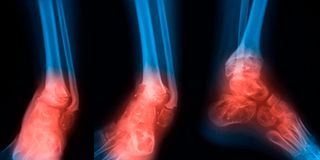When bacteria and fungi invade your bones

Osteomyelitis refers to infection of the bone. This happens when disease-causing organisms like bacteria, mycobacteria and fungi infect the bone, causing inflammation.
What you need to know:
- Any condition that affects blood supply or lowers the immunity puts the person at higher risk of developing osteomyelitis.
- When someone has osteomyelitis, they may have redness, warmth and swelling around the affected area. The person may also develop fever. For some people, there may be no symptoms.
Dear Doc,
Please explain about Osteomyelitis
Dear Alnashir,
Osteomyelitis refers to infection of the bone. This happens when disease-causing organisms like bacteria, mycobacteria and fungi infect the bone, causing inflammation. The infection may be acute, lasting for several days, or it may be chronic, lasting for a long time.
Healthy bone is usually resistant to infection. However, infection can reach the bone through various ways:
- Through the blood stream, with infection spreading from a distant site to the bone
- Through spread from surrounding tissue infection such as from the skin and soft tissues
- From trauma to the bone
- Following surgery or after insertion of a foreign body such as a prosthesis or implant
- As a result of poor blood supply leading to tissue damage such as a result of diabetes mellitus
Any condition that affects blood supply or lowers the immunity puts the person at higher risk of developing osteomyelitis.
When someone has osteomyelitis, they may have redness, warmth and swelling around the affected area. The person may also develop fever. For some people, there may be no symptoms.
Osteomyelitis is diagnosed from physical examination and relevant tests that may include blood tests, imaging (X-rays and/or scans) and bone biopsy. Treatment may involve use of intravenous and oral antibiotics specific to the type of infection, given for several weeks. Surgery may also be required to remove any accumulated pus or fluid, to remove any diseased or dead bone and other tissue, and to remove any foreign materials. The area that is cleaned out may be covered with a tissue or bone graft once it heals to help the body repair. In dire circumstances, an amputation may be done to prevent spread of infection.
Good morning Doc,
I would like to ask if there is a remedy for baldness. Mark you I’m just 30 and it's eating my hair up. I was advised to use virgin hair fertiliser but I am a bit scared. MP
Dear MP,
This type of hair loss is likely to be male pattern baldness or androgenic alopecia. The hair loss is associated with the male sex hormones known as androgens. It is also associated with genetics. Hair loss also increases with advancing age, especially after the age of 50.
One of the functions of androgens is regulating the growth of hair. Each hair strand has a growth cycle and at the end of the cycle, the hair falls off and a new strand starts growing from the hair follicle. With androgenic alopecia, the hair follicle shrinks and produces hair that is thinner, finer and shorter, and over time, there’s no more hair growth from that follicle.
The hair thinning and loss may start from the top of the head, the front or from the sides, and it may affect a specific area or extend to the entire head.
There is no effective way of preventing male pattern baldness. However, stress management can delay the onset since stress may increase the level of the androgen hormones.
Once the hair thinning and hair loss begins, creative hair-cuts can help to cover up the hair loss or to make the hair look fuller and thicker.
There are some medications that may be prescribed such as minoxidil cream, which may slow down hair loss and stimulate new hair growth, or use of finasteride, a medication which blocks the androgen hormones and slows down hair loss. These medications require close monitoring by a health professional because of possible severe side effects. Also, the impact of the medication may take several months to be visible. There is also an option of hair transplants from areas with active hair growth to areas with hair loss. The other option is to use a wig or a toupee.
There are many herbal preparations that are touted to have hair growth benefits though there are very few studies to support them.
Virgin hair fertiliser is indicated as having lanolin, shea butter, menthol oil, peppermint oil and herbal extract as the active ingredients. While the herbal extract is unknown, a study on mice found that peppermint oil increased hair growth.
Dear doctor
What can I do to add some weight? I am slender despite much effort to add some weight.
Chris
Dear Chris,
Since being slender is relative, it would be good for you to have an objective assessment of your weight to determine whether it’s okay for you. This may be done through anthropometric measurements, which are quantitative body measurements carried out by a health care worker. The most commonly used measurement is the body mass index (BMI). This is calculated by the weight in kilogrammes being divided by the height in metres squared. For example, with a weight of 70kg and a height of 1.7m, the BMI would be 70 divide by 1.7m squared, which would be 70 divide by 2.89. This would give you 24.22 kg/m2. A normal BMI is between 18 and 25. Other anthropometric assessments are waist circumference, waist-to-hip ratio, skin fold thickness, mid-upper arm circumference and bioelectrical impedance.
If you are underweight, you will benefit from a full nutritional assessment in addition to evaluation for any underlying causes of the same.
If your weight is within normal range, you can consult with a nutritionist on the best, healthy diet for you. This is in addition to adopting and/or maintaining other healthy habits like regular exercise.
Due to individual differences, the rate at which a person gains or loses weight is different. As long as the weight is within the normal range and there are no health concerns, then there’s no need to worry.




